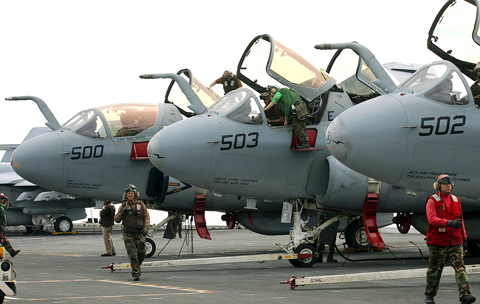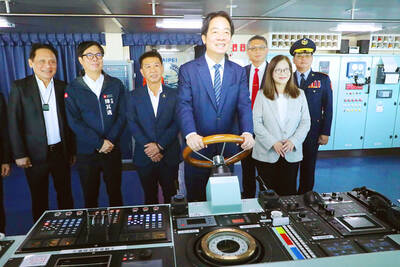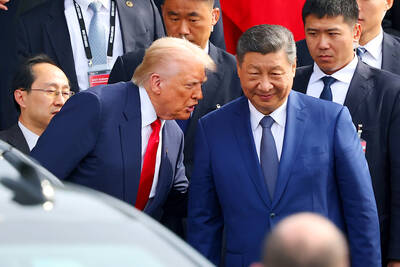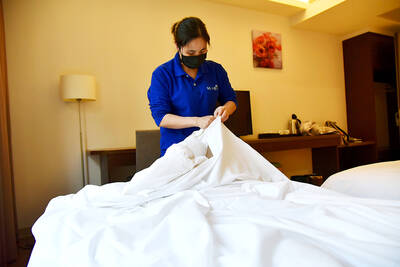A nuclear-powered US supercarrier led an armada of warships in exercises off the Korean peninsula yesterday that North Korea has vowed to physically block and says could escalate into nuclear war.
US military officials said the maneuvers, conducted with South Korean ships and Japanese observers, were intended to send a strong signal to the North that aggression in the region would not be tolerated.
Tensions on the Korean peninsula have been particularly high since the sinking in March of a South Korean naval vessel. Forty-six Korean sailors were killed in the sinking, which Seoul has called Pyongyang’s worst military attack on it since the 1950 to 1953 Korean War.

PHOTO: AP
The military drills, code-named “Invincible Spirit,” are to run through Wednesday with about 8,000 US and South Korean troops, 20 ships and submarines and 200 aircraft. The Nimitz-class USS George Washington was deployed from Japan.
“We are showing our resolve,” said Captain David Lausman, the carrier’s commanding officer.
North Korea has protested the drills, threatening to retaliate with “nuclear deterrence” and “sacred war.”
The North routinely threatens attacks whenever South Korea and the US hold joint military drills, which Pyongyang sees as a rehearsal for an invasion. The US keeps 28,500 troops in South Korea and another 50,000 in Japan, but says it has no intention of invading the North.
Still, the North’s latest rhetoric carries extra weight following the sinking of the Cheonan.
Captain Ross Myers, the commander of the carrier’s air wing, said the exercises were not intended to raise tensions, but acknowledged they are meant to get North Korea’s attention.
The George Washington, one of the biggest ships in the US Navy, is a potent symbol of US military power, with about 5,000 sailors and aviators and the capacity to carry up to 70 planes.
“North Korea may contend that it is a provocation, but I would say the opposite,” he said. “It is a provocation to those who don’t want peace and stability. North Korea doesn’t want this. They know that one of South Korea’s strengths is its alliance with the United States.”
He said North Korea’s threats to retaliate were being taken seriously.
“There is a lot they can do,” he said. “They have ships, they have subs, they have airplanes. They are a credible threat.”
The exercises are the first in a series of US-South Korean maneuvers to be conducted in the East Sea off South Korea’s east coast and in the Yellow Sea closer to China’s shores in international waters. The exercises also are the first to employ the F-22 stealth fighter — which can evade North Korean air defenses — in South Korea.
South Korea was closely monitoring North Korea’s military, but spotted no unusual activity yesterday, the Defense Ministry said.
North Korea, which denies any involvement in the sinking of the Cheonan, warned the US against holding the drills.
“Our military and people will squarely respond to the nuclear war preparation by the American imperialists and the South Korean puppet regime with our powerful nuclear deterrent,” the North’s government-run Minju Joson newspaper said in a commentary yesterday headlined, “We also have nuclear weapons.”
The commentary was carried by the official Korean Central News Agency.
The North’s powerful National Defense Commission issued a similar threat on Saturday, saying the country “will start a retaliatory sacred war.” Its Foreign Ministry separately said on Saturday that Pyongyang was considering “powerful physical measures” in response to the US military drills and sanctions.

CALL FOR SUPPORT: President William Lai called on lawmakers across party lines to ensure the livelihood of Taiwanese and that national security is protected President William Lai (賴清德) yesterday called for bipartisan support for Taiwan’s investment in self-defense capabilities at the christening and launch of two coast guard vessels at CSBC Corp, Taiwan’s (台灣國際造船) shipyard in Kaohsiung. The Taipei (台北) is the fourth and final ship of the Chiayi-class offshore patrol vessels, and the Siraya (西拉雅) is the Coast Guard Administration’s (CGA) first-ever ocean patrol vessel, the government said. The Taipei is the fourth and final ship of the Chiayi-class offshore patrol vessels with a displacement of about 4,000 tonnes, Lai said. This ship class was ordered as a result of former president Tsai Ing-wen’s (蔡英文) 2018

UKRAINE, NVIDIA: The US leader said the subject of Russia’s war had come up ‘very strongly,’ while Jenson Huang was hoping that the conversation was good Chinese President Xi Jinping (習近平) and US President Donald Trump had differing takes following their meeting in Busan, South Korea, yesterday. Xi said that the two sides should complete follow-up work as soon as possible to deliver tangible results that would provide “peace of mind” to China, the US and the rest of the world, while Trump hailed the “great success” of the talks. The two discussed trade, including a deal to reduce tariffs slapped on China for its role in the fentanyl trade, as well as cooperation in ending the war in Ukraine, among other issues, but they did not mention

HOTEL HIRING: An official said that hoteliers could begin hiring migrant workers next year, but must adhere to a rule requiring a NT$2,000 salary hike for Taiwanese The government is to allow the hospitality industry to recruit mid-level migrant workers for housekeeping and three other lines of work after the Executive Yuan yesterday approved a proposal by the Ministry of Labor. A shortage of workers at hotels and accommodation facilities was discussed at a meeting of the legislature’s Transportation Committee. A 2023 survey conducted by the Tourism Administration found that Taiwan’s lodging industry was short of about 6,600 housekeeping and cleaning workers, the agency said in a report to the committee. The shortage of workers in the industry is being studied, the report said. Hotel and Lodging Division Deputy Director Cheng

‘SECRETS’: While saying China would not attack during his presidency, Donald Trump declined to say how Washington would respond if Beijing were to take military action US President Donald Trump said that China would not take military action against Taiwan while he is president, as the Chinese leaders “know the consequences.” Trump made the statement during an interview on CBS’ 60 Minutes program that aired on Sunday, a few days after his meeting with Chinese President Xi Jinping (習近平) in South Korea. “He [Xi] has openly said, and his people have openly said at meetings, ‘we would never do anything while President Trump is president,’ because they know the consequences,” Trump said in the interview. However, he repeatedly declined to say exactly how Washington would respond in